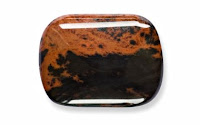 In its most natural state a natural volcanic glass, Obsidian forms when lava solidifies so quickly those mineral crystals do not have time to grow. The name Obsidian simply refers to the glassy texture and technically obsidian can have any chemical composition. However, most obsidian is similar in composition to Rhyolite, and is commonly found on the outer edges of Rhyolite domes and flows. Like rhyolite, obsidian can show flow-banding.
In its most natural state a natural volcanic glass, Obsidian forms when lava solidifies so quickly those mineral crystals do not have time to grow. The name Obsidian simply refers to the glassy texture and technically obsidian can have any chemical composition. However, most obsidian is similar in composition to Rhyolite, and is commonly found on the outer edges of Rhyolite domes and flows. Like rhyolite, obsidian can show flow-banding. 
It is also found along the rapidly cooled edges of dykes and sills. Obsidian is typically jet-black, although with the presence of hematite (iron oxide) the color change can vary from red to brown varieties; with the inclusion of tiny gas bubbles it can create a golden sheen. The appearance of ‘white snowflakes’ in obsidian are caused by spherulites, spherical aggregates of needle-like crystals.
In the Stone Age obsidian was used to make weapons and blades. It has been used in magic rituals since time immemorial and in fortune telling it was used as a mirror. The stone helps alleviate pain, reduce tension and release energy. Some people wear it to improve circulation and it is said it can be used to treat trauma, shock and anxiety attacks. It is the Star Sign associated with
fortune telling it was used as a mirror. The stone helps alleviate pain, reduce tension and release energy. Some people wear it to improve circulation and it is said it can be used to treat trauma, shock and anxiety attacks. It is the Star Sign associated with  Scorpio and Sagittarius.
Scorpio and Sagittarius.
In the Stone Age obsidian was used to make weapons and blades. It has been used in magic rituals since time immemorial and in
 fortune telling it was used as a mirror. The stone helps alleviate pain, reduce tension and release energy. Some people wear it to improve circulation and it is said it can be used to treat trauma, shock and anxiety attacks. It is the Star Sign associated with
fortune telling it was used as a mirror. The stone helps alleviate pain, reduce tension and release energy. Some people wear it to improve circulation and it is said it can be used to treat trauma, shock and anxiety attacks. It is the Star Sign associated with  Scorpio and Sagittarius.
Scorpio and Sagittarius. To care for obsidian it must be discharged once a month under warm water and then recharged in the sun or among rock crystals. It is said to also bring clarity, deflecting negativity, protection, and healing powers to those who use or wear the stone.
*Re-printed from various mineral gemstone books and websites.

















